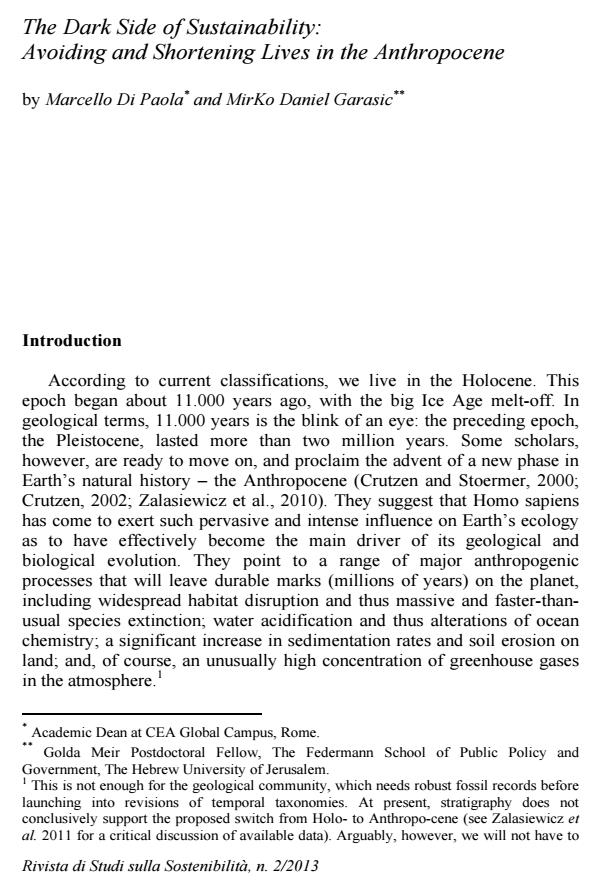The Dark Side of Sustainability: Avoiding and Shortening Lives in the Anthropocene
Titolo Rivista RIVISTA DI STUDI SULLA SOSTENIBILITA'
Autori/Curatori Marcello Di Paola, MirKo Daniel Garasic
Anno di pubblicazione 2014 Fascicolo 2013/2
Lingua Inglese Numero pagine 23 P. 59-81 Dimensione file 656 KB
DOI 10.3280/RISS2013-002004
Il DOI è il codice a barre della proprietà intellettuale: per saperne di più
clicca qui
Qui sotto puoi vedere in anteprima la prima pagina di questo articolo.
Se questo articolo ti interessa, lo puoi acquistare (e scaricare in formato pdf) seguendo le facili indicazioni per acquistare il download credit. Acquista Download Credits per scaricare questo Articolo in formato PDF

FrancoAngeli è membro della Publishers International Linking Association, Inc (PILA)associazione indipendente e non profit per facilitare (attraverso i servizi tecnologici implementati da CrossRef.org) l’accesso degli studiosi ai contenuti digitali nelle pubblicazioni professionali e scientifiche
In this paper, we critically rehearse the morality of avoiding and shortening the lives of present and future consumers in order to decrease humanity’s impact on global eco-systems and spare scarce natural resources in the Anthropocene. Our main objective is not originality, but rather providing a short tour of some relatively unexplored recesses of moral reflection, as it tackles practices of sustainability that may not accord easily with our wishes about what life in our own geological epoch should have been like. We shall discuss these practices only as moral options to be embraced by individuals voluntarily, out of a sense of obligation (or perhaps also in pursuit of various benefits that may be offered as positive incentives) - not as coerced, mandatory activities imposed on individuals by some agents, such as governments.
L’articolo esplora un lato oscuro della sostenibilità, valutando la moralità dell’evitare o di accorciare le vite di consumatori presenti e futuri con l’obbiettivo di diminuire l’impatto umano su ecosistemi globali e risparmiare preziose risorse naturali che diverranno sempre meno abbondanti in quella che molti ormai considerano l’epoca dell’uomo - l’Antropocene. Discuteremo tali pratiche esclusivamente come opzioni che gli individui potrebbero decidere di adottare volontariamente, spinti da un senso di obbligo morale (o forse anche in vista di vari benefici che potrebbero esser offerti quali incentivi) - non come pratiche che possano esser imposte coercitivamente sugli individui da agenti terzi, come ad esempio i governi.
Parole chiave:Antropocene, riflessioni morali, consumatori attuali e futuri, evitare e accorciare le vite
- Guantanamo and Other Cases of Enforced Medical Treatment Mirko Daniel Garasic, pp.19 (ISBN:978-3-319-22652-1)
Marcello Di Paola, MirKo Daniel Garasic, The Dark Side of Sustainability: Avoiding and Shortening Lives in the Anthropocene in "RIVISTA DI STUDI SULLA SOSTENIBILITA'" 2/2013, pp 59-81, DOI: 10.3280/RISS2013-002004